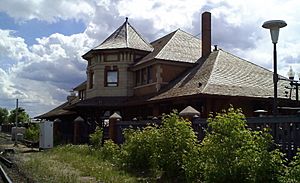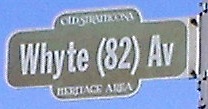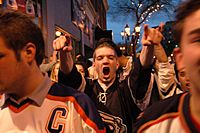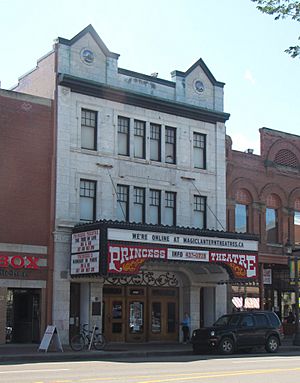Old Strathcona facts for kids
Quick facts for kids Old Strathcona |
|
|---|---|

The 1908 Strathcona Railway Station, just south of Whyte Avenue in the centre of Old Strathcona.
|
|
| Location | Edmonton, Alberta, Canada |
| Area | 3.24 ha (8.0 acres) |
| Built | 1891-1913 |
| Architectural style(s) | Late Victorian, Edwardian |
| Governing body | City of Edmonton |
| Provincial Historic Area | 2007 |
| Lua error in Module:Location_map at line 420: attempt to index field 'wikibase' (a nil value). | |
Old Strathcona is a special historic district in south-central Edmonton, Alberta, Canada. It used to be the main business area of the separate city of Strathcona. Today, Old Strathcona is a lively spot filled with many of Edmonton's arts and entertainment places. It's also a popular shopping area for people living nearby and students from the University of Alberta. Many shops here are run by their owners, but you'll also find some bigger chain stores. This area is home to a lot of Edmonton's theatres and places where you can watch live shows. The heart of the district is Whyte (82) Avenue, which is famous for its shops, restaurants, bars, and street performers called buskers.
Contents
What Makes Old Strathcona Special?
A Provincial Historic Area
In 2007, Old Strathcona was named Alberta's second Provincial Historic Area. This means it's a very important place with a lot of history that the province wants to protect. The historic district covers five city blocks, stretching from 85 Avenue south to 80 Avenue and from 102 Street west to 106 Street.
A Business Revitalization Zone
The Old Strathcona and Area Business Revitalization Zone (BRZ) is a special area designed to help local businesses grow and improve. It's shaped like a cross, running along Whyte Avenue from just west of 109 Street to just east of 99 Street. It also goes along Gateway Boulevard from 86 Avenue in the north to University Avenue in the south. This zone helps make Old Strathcona a great place to visit and shop.
History of Old Strathcona
Old Strathcona was once its own town, separate from Edmonton. It became a town in 1899 and then a city in 1907. In 1912, the City of Strathcona joined with Edmonton.
A big reason Whyte Avenue is so popular is because of its old buildings. Many of them are more than 100 years old! The oldest building is the Strathcona Hotel at 10302 Whyte Avenue. It was built in 1891 by the railway and was the biggest hotel in the area until 1904. During a time when alcohol was not allowed (1918-1924), the hotel was used as a college for young women.
At first, most buildings were made of wood. But in 1902, the Town of Strathcona made a rule that new buildings in the downtown area had to be made of brick. This was to help stop big fires. Many of the brick buildings you see today were built between 1910 and 1912. This was a busy time when thousands of new people came to the area from other parts of Canada, Britain, Europe, and the U.S. In the early 1890s, Whyte Avenue mostly had simple shack homes and quickly built pioneer stores. These were soon replaced by stronger two-storey wooden buildings or even brick ones, like the Ross Block, before the brick rule was made.
In 2005, the Edmonton City Council asked the Province of Alberta to give the area special heritage status. This led to Old Strathcona becoming a Provincial Heritage Area in 2007.
Historic Buildings and Recognition
Old Strathcona is Alberta's second Provincial Historic Area. The first was downtown Fort Macleod. Old Strathcona has many important historic buildings.
The Provincial Historic Area covers about five square blocks. This was the main business part of the old city of Strathcona. It goes from 85 Avenue south to 80 Avenue and from 102 Street west to 106 Street. Inside this area are many of the most important buildings from Strathcona's early boom. This boom happened after the Calgary and Edmonton Railway arrived in 1891 and lasted until a real estate crash in 1913–14. Some of the heritage buildings in this area include the Strathcona Hotel, the Gainers Block, the Orange Hall, the Canadian Pacific Railway Station, the South Side Post Office, the Douglas Block, the Princess Theatre, the Strathcona Public Library, the Connaught Armoury, and Old Scona Academic High School.
Outside this main historic area, in the wider Old Strathcona district, there are also other protected heritage buildings. These include churches and homes. In the Edmonton-Strathcona provincial area, which covers most of the old city of Strathcona, there are 18 Provincial Historic Resources and 11 Registered Historic Resources recognized by the Government of Alberta. The City of Edmonton also recognizes 14 Municipal Historic Resources. Some buildings are on both lists!
Old Strathcona Today
After Strathcona and Edmonton joined together, Strathcona's economy slowed down. Not many new buildings were built, which helped keep many of the old buildings standing today. In the 1970s, Edmonton's city council bought many properties to build a freeway through the historic area. But a "Save-the-district" movement started, and the plan was stopped.
After that, Old Strathcona became more Bohemian, meaning it attracted artists and people with unique styles. It also continued to serve its original purpose of providing goods and services to local residents, students at the nearby University of Alberta, and people from the County of Strathcona.
The Strathcona Hotel, the first building built after the railway arrived in 1891, has been open ever since (except for the time when alcohol was not allowed, from 1916-1923). Other places to gather have always been in the district. In the 1990s, many new places for entertainment opened in old Whyte Avenue buildings that used to be offices or shops. The area's night-time feel started to change a lot, becoming a popular spot for fun and excitement.
Over time, Old Strathcona has become the top entertainment area in Edmonton. It hosts big events like the Edmonton International Fringe Festival. While it didn't have many alternative music venues for a while, live music is making a strong comeback on Whyte Avenue. Many places now offer live entertainment for different types of music. The main area for clubs and nightlife is on Whyte Avenue between 99 and 109 Streets, with most places directly on Whyte Avenue or on nearby side streets.
Whyte Avenue is still a center for unique lifestyles in Edmonton. It has many independent clothing stores and other shops that cater to different styles, like hippie, raver, and goth. Clothing stores are one of the fastest-growing businesses here. Old Strathcona is known for its many small, local, and independent businesses.
There are also many restaurants in this area, with many of them being locally owned. Several of the entertainment spots also have kitchens. In total, there are almost 100 places to eat in Old Strathcona.
Theatre Scene
Old Strathcona has a lively independent theatre scene. Nine theatre companies perform in several buildings in the neighborhood, including the Varscona Theatre and The Walterdale Playhouse. The Varscona Theatre alone is home to several award-winning groups, like Shadow Theatre, Teatro la Quindicina, Plain Jane Theatre Company, the variety show That's Terrific!, and the improvisation group Die-Nasty. Every August, Old Strathcona hosts the Edmonton International Fringe Festival. This is the largest and oldest Fringe Theatre event in North America. Edmonton historian Lawrence Herzog said that the variety of shows in the Old Strathcona Theatre District is "wide and astonishing."
Cinema
Old Strathcona is also known for its art house movie theatres, The Princess Theatre and the Garneau Theatre. In 2011, Edmonton's Metro Cinema Society started managing the Garneau Theatre. The Princess Theatre was managed by Magic Lantern Theatres for a short time, until the building owners, the Brar family, took over the business.
Events in Old Strathcona
Old Strathcona celebrates all year long! In January, you can enjoy Ice on Whyte, which is a sculpting competition and an outdoor ice playground. June brings Improvaganza, an international improv festival hosted by Rapid Fire Theatre. In mid-July, the Whyte Avenue ArtWalk features more than 230 artists working on the sidewalks of Old Strathcona. On the last Sunday of Artwalk, Whyte Avenue closes the entire street for a huge Street Sale. In August, the Edmonton International Fringe Festival welcomes hundreds of thousands of theatre fans and festival visitors. The fall brings the Chante Festival and many events during the Edmonton Halloween festival.
Old Strathcona also has a farmers' market that is open all year. All the sellers at this market must be the ones who actually grow or make the products. About 10,000 customers visit Edmonton's market garden industry every Saturday.
Whyte (82) Avenue
 |
|
|---|---|
| 82 Avenue | |
| Namesake | Sir William Whyte |
| Maintained by | the City of Edmonton |
| Length | 7.2 km (4.5 mi) |
| Location | Edmonton |
| West end | 114 Street / University Avenue |
| Major junctions |
109 Street, 104 Street, Gateway Boulevard, 75 Street |
| East end | Sherwood Park Freeway |
| Construction | |
| Inauguration | 1890s |
Whyte (82) Avenue is a major road in south-central Edmonton, Alberta, Canada. It became the main street of the City of Strathcona when that city was formed, and now it runs right through Old Strathcona. The road was named in 1891 after Sir William Whyte. He was an important manager for the CPR railway from 1886 to 1897 and was honored by King George V in 1911. Whyte (82) Avenue is part of a 40-kilometer (about 25-mile) long road that goes through Sherwood Park, Edmonton, and St. Albert. This longer road also includes Wye Road, Sherwood Park Freeway, parts of University Avenue and Saskatchewan Drive, Groat Road, and St. Albert Trail.
This road was originally the center of the former city of Strathcona. It divided the city into north and south areas. The street called Main Street, which is now 104 Street (Calgary Trail), divided the city into west and east areas. In 1912, when Edmonton and Strathcona joined, Edmonton started using its current street numbering system. Whyte Avenue was also given the name 82 Avenue, so it could keep both names. As Alberta's highway system grew, Whyte Avenue became part of Highway 1 (later Highway 2) between 104 Street and 109 Street. East of 104 Street, it was part of Highway 14. These highway names were moved to Whitemud Drive in the 1980s.
A small part of 82 Avenue also exists as a smaller road between 71 Street and 50 Street, where the main road changes into the Sherwood Park Freeway.
The Blue Mile

The Blue Mile or Copper Kilometre is a nickname given by local media to Whyte Avenue in Old Strathcona. This happened during the Edmonton Oilers' amazing playoff run in the 2006 Stanley Cup playoffs. It was similar to what happened on the Red Mile in Calgary two years before.
After the Edmonton Oilers surprisingly beat the Detroit Red Wings in the first round of the 2006 playoffs, thousands of Oilers fans gathered on Whyte Avenue. They turned the area into a huge hockey party! Fans walked the streets, cheering, chanting, high-fiving, honking horns, and waving flags for their team. Some even rode on top of crowds in grocery carts, and others climbed trees and traffic lights to celebrate.
Neighbourhoods Along Whyte Avenue
Whyte (82) Avenue runs through these neighbourhoods, from west to east:
- Garneau
- Queen Alexandra
- Strathcona
- Ritchie
- Bonnie Doon
- King Edward Park
- Idylwylde
- Kenilworth



